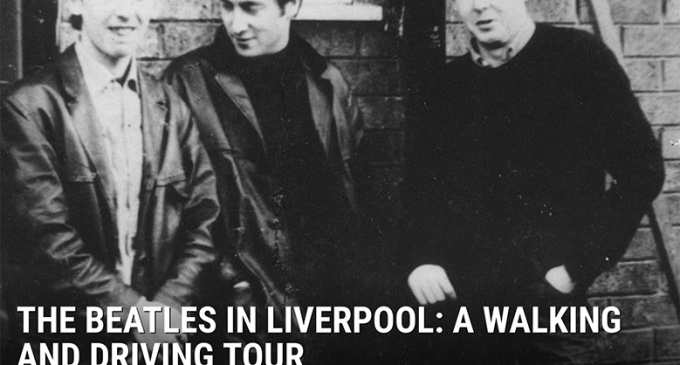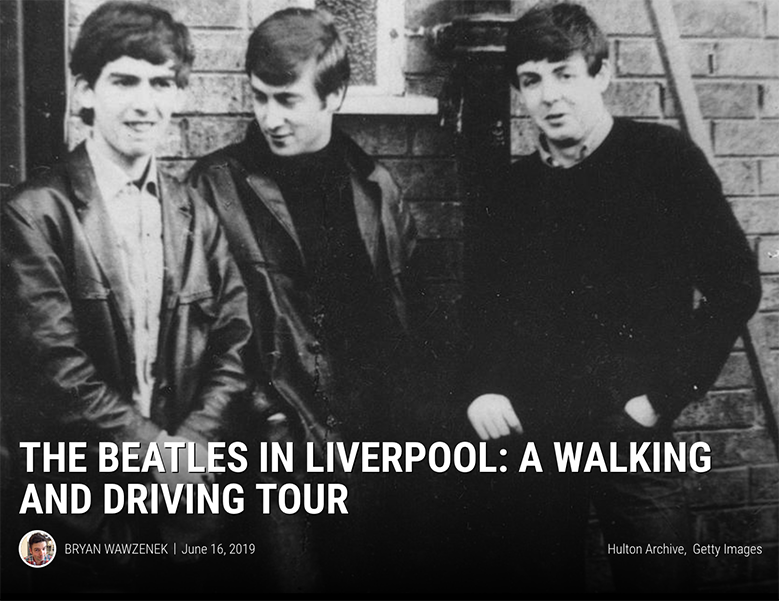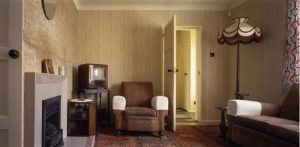The Beatles in Liverpool: A Walking and Driving Tour

Liverpool’s tourism industry seems to thrive on the city’s most famous sons: John, Paul, George and Ringo.
If you look past the souvenir shops, pubs named for band members and rampant urban redevelopment, a visitor on a Beatles pilgrimage can encounter plenty of sites that contributed to the beloved group’s musical heritage. All you need is love … plus a little imagination and a decent pair of walking shoes for this tour of the Beatles’ Liverpool.
For a city that’s inextricably tied to the most famous band in music history, Liverpool has a spotty record when it comes to preserving its Beatles-related history. Ringo Starr’s childhood home barely escaped the wrecking ball. The same can’t be said for a handful of other buildings that had a massive impact on pop music in one way or another. When it comes to Beatles locations in Liverpool, some are gone and some remain … and at least one had to be totally rebuilt due to shortsighted city planning decisions.
But Beatles fans still can find a range of sites to see if they know where to look. The below tour includes 10 walkable downtown locations with Fab Four connections, followed by an assortment that are probably best visited by car (or a Magical Mystery Tour bus). The trek begins dockside, on the “cast iron shore” of the river Mersey.
Bryan Wawzenek
Statue of the Beatles (Pier Head)
Not strictly a historic site, these larger-than-life bronze statues of the lads, circa 1964, were unveiled in 2015. Sculptor Andy Edwards included little “Easter eggs” for each member. Paul McCartney clutches a camera (for his late wife, Linda), George Harrison’s belt features Sanskrit writing (signifying his spiritual passions), Ringo Starr’s shoe has the number eight on its rubber sole (Liverpool 8 is the postcode for his childhood home). And John Lennon holds two acorns (a nod to his and Yoko Ono’s campaign for peace). It’s no accident that the Beatles face away from Liverpool, caught mid-stride as they become this port city’s most famous export. The Beatles Story museum is a short walk down the waterfront. On the way, you might find the statue of Billy Fury, the Liverpool-born rock star whose fame preceded Beatlemania.Bryan Wawzenek
The Cavern Club (10 Mathew St.)
With lunchtime shows and evening gigs, the Beatles built a rabid local following here … well, not quite here. About a decade after the group made the Cavern “the most famous club in the world,” the original subterranean venue was closed and filled in to allow for construction on an underground rail loop. Another decade later, in the early ’80s, an attempt to reopen the club was thwarted by the structural damage that had already been done. Instead, a recreated version of the Cavern, which was designed to mimic the original as much as possible, was opened next door. That club remains a tourist attraction, festooned with memorabilia and featuring hordes of musicians playing Beatles covers. Walk a few flights down and see if you can pick out the next superstars, the way Beatles manager Brian Epstein did in 1961.Bryan Wawzenek
Mathew Street
Once you make your way back to street level, there are a few features of note on and around narrow Mathew Street, also known as the “Cavern Quarter.” A statue of John Lennon, wearing his early Beatles leather outfit, faces the entrance of the new Cavern. In front of the club’s original entrance stands a statue of Cilla Black, who was the venue’s hat check girl before she became a star (with some songwriting help from the Beatles). Sculptor Arthur Dooley’s bizarre tribute to the band – ‘Four Lads Who Shook the World’ adorns a wall. The Hard Days Night Hotel is around the corner and there are a few run-of-the-mill and refined Beatles souvenir shops nearby. Music venues and pubs also abound, which brings us to …Bryan Wawzenek
The Grapes (25 Mathew St.)
This pub was one of a few frequented by the Beatles before, after and between gigs. To avoid underage drinking issues, the Cavern didn’t serve alcohol, so the young Beatles had to drink elsewhere. In the early ’60s, the band members would follow a lunchtime concert with a round or two at the Grapes – there’s a picture inside the pub of them doing just that in the Pete Best era. They preferred to imbibe black velvet, which is cider mixed with Guinness.Bryan Wawzenek
Hessy’s Music Centre (62 Stanley St.)
Around the corner from the eastern end of Mathew Street lies the former location of the musical instruments shop where the Beatles purchased some of their gear in the early days. Paul McCartney’s first guitar came from a different Hessy’s location, but John Lennon’s first electric guitar was purchased, with the help of his Aunt Mimi, in 1959 at Frank Hessy’s shop on Stanley Street. George Harrison, Ringo Starr and Stuart Sutcliffe all bought instruments here too, usually “on the drip.” That’s local slang for putting some money down and furnishing the rest through a weekly payment plan. Through Liverpool’s jazz, skiffle and rock ’n’ roll booms, there were more than a few musicians indebted to Mr. Hessy.Bryan Wawzenek
Rushworth’s Music House (Whitechapel and Richmond Street)
A few minutes’ walk from Hessy’s was the location of the music shop’s main competitor, Rushworth’s (also since gone). With little to do before (or between) gigs, the young Beatles would spend some of their time between the two stores, ogling the guitars. The second of the two stores was owned by Rushworth and Dreaper, an organ manufacturer that had expanded into selling all sorts of musical instruments. In 1962, Rushworth’s sold John Lennon and George Harrison their most expensive instruments yet: a pair of electrified acoustic Gibson J-160Es. The guitars were shipped from America and signed for by manager Brian Epstein, whose family’s music store was located just down Whitechapel.Bryan Wawzenek
NEMS (12-14 Whitechapel)
In the early ’60s, John Lennon, Paul McCartney and George Harrison were an inseparable triumvirate that frequented three shops in downtown Liverpool. They went to Hessy’s and Rushworth’s for the instruments; they went to NEMS for records. Owned by the Epstein family, NEMS (North End Music Stores) only recently had moved into the city center, with locations run by the youngest family members: Clive and Brian. But before the Beatles knew Brian Epstein, they came to NEMS to hear the latest American rock ’n’ roll, blues and R&B singles. All three would crowd into listening booths and claim new songs for the band’s live show. In 1961, not long after Epstein saw that show, he invited the band to NEMS on Whitechapel to sign a management contract. With Epstein’s crucial assistance, the Beatles had a record deal and a hit single within the year. Unfortunately, the building was torn down and a Forever 21 now sits on the spot where the Beatles found musical inspiration and a devoted advocate.Bryan Wawzenek
The Jacaranda (21-23 Slater St.)
If some of the downtown Beatles sites remain in address or “blue plaque” form only, the Jacaranda is still there. Located in the Ropewalks neighborhood, “the Jac” was a bohemian snack bar that hosted live music nights in the former coal cellar. Owned by Allan Williams, the Beatles’ first manager, The Jacaranda became a prime hangout for the members, who also performed in the downstairs club. The Jac, which was refurbished and reopened in 2014, still hosts open-mic nights and now is home to a record shop on the ground floor.Bryan Wawzenek
Blue Angel Night Club (106-108 Seel St.)
Another club formerly owned by Williams is situated a few minutes down nearby Seel Street: the Blue Angel. Two important moments in Beatles lore happened here. In 1960, the band (temporarily called the Silver Beetles) auditioned to back Billy Fury on a tour. They didn’t land the job, but they impressed just enough to score a nine-date trek in Scotland with Johnny Gentle. The May tour would be the Beatles’ first. The Blue Angel also hosted Pete Best’s audition, in August 1960, to join the perpetually drummer-less group before the band began its first stint in Hamburg, Germany. The club is still there, and apparently draws a student crowd, but probably not many destined for fame via the Reeperbahn.Bryan Wawzenek
Joe’s Restaurant (139 Duke St.)
More commonly called Joe’s Café (or “caff,” in a proper Scouse accent), this small diner was another of the Beatles’ favored hangouts – mostly because it stayed open until 4AM. Supposedly, this is where Brian Epstein broke the news to the Beatles that they had not been offered a recording contract by Decca in early 1962. One of the spoken interstitials on the ‘Live at the BBC’ compilation features Paul McCartney name-checking “Joe’s Caff” as a place that he can no longer go because of the band’s high profile. A couple of other pre-fame Beatles hangouts are nearby – John Lennon’s favorite pub, Ye Cracke, and the Philharmonic Dining Rooms, where McCartney returned in 2018 for a ‘Carpool Karaoke’ segment with James Corden.Bryan Wawzenek
Farther Flung Beatles Sites
In the early days, the Beatles usually took the bus to get from their homes to pubs, clubs and performance venues, but to visit this next batch of sites – some of them iconic – it helps to have a car or join an official tour. Driving to the sites in the order below would take you in a counterclockwise half-loop southward from central Liverpool and back around.Bryan Wawzenek
Ringo Starr’s and George Harrison’s Childhood Homes (10 Admiral Grove and 12 Arnold Grove)
None of the Beatles came from posh backgrounds, a point driven home by the small size of Starr’s and Harrison’s family homes, clustered among others in tight rows. Harrison lived on Arnold Grove, with an outhouse in the back, until he was six, when the Harrisons moved out to Speke. Starr lived with his mother at 10 Admiral Grove in Toxteth from age three until the Beatles hit it big. As mentioned earlier, this house narrowly survived demolition following a public outcry. The entire block of homes was renovated instead.Bryan Wawzenek
Penny Lane Roundabout (Penny Lane and Smithdown Place)
Beatles fans take a drive down Penny Lane and pose for pictures with the street sign, but the song’s lyrics depict the goings-on near “the shelter in the middle of the roundabout.” As young men, the boys spent a fair amount of time at this bus shelter – which later became a Beatles-themed restaurant, although it has since closed – because it was where they would transfer to get to central Liverpool and back. The barber shop is still there (joined by a few others), but the fire engine never was (the station was located nearby). Also nearby is St. Barnabas Church, where Paul McCartney gave his first public performance as a nine-year-old member of the choir.Bryan Wawzenek
Strawberry Field (16 Beaconsfield Road)
Paul McCartney wasn’t the only Beatle who got nostalgic for Liverpool memories. At roughly the same time he wrote “Penny Lane,” John Lennon’s “Strawberry Fields Forever” took inspiration from Strawberry Field, a Salvation Army children’s home near his boyhood home in Woolton. Young Lennon would scale the fence to play with the kids. He also attended the annual Salvation Army garden party with his Aunt Mimi. The site is currently undergoing repairs, with plans to open the red gates to visitors who can explore an exhibition about Lennon’s early days and “Strawberry Fields Forever.”Bryan Wawzenek
Mendips – John Lennon’s Childhood Home (251 Menlove Ave.)
For most of his childhood, John Lennon grew up with his Aunt Mimi at a middle-class home named Mendips. In 2002, Lennon’s widow Yoko Ono bought the property and donated it to England’s National Trust, which restored the home and now runs tours of Mendips (combined with tours of Paul McCartney’s childhood home). Tour participants are welcomed by a guide to enter through the kitchen – just as McCartney did when he first came to see Lennon – hear stories of Lennon’s youth, see the living room where the Quarrymen practiced and visit the bedroom where Lennon lay awake listening to the rock ’n’ roll broadcasts of Radio Luxembourg. Lennon lived her from the age of five until he was 22 (and a rock star). But the only way inside is with a National Trust tour, which typically requires advance booking. Side note: St. Peter’s Church is a short walk away. That’s where Lennon and McCartney first met at the Woolton fete and also where Eleanor Rigby is buried (along with her name).Bryan Wawzenek
Paul McCartney’s Childhood Home (20 Forthlin Road)
As burgeoning musicians, John Lennon and Paul McCartney would walk 20 minutes (taking a short cut through a local golf course) to the other’s house to listen to music, play their guitars and write songs. A host of early Lennon-McCartney originals were worked out at 20 Forthlin Rd., a council house inhabited by McCartney, his dad Jim and his brother Mike. McCartney’s mother Mary had moved with them to the house in 1955, but died of an embolism the following year, when McCartney was 14. The National Trust, which has owned the home since 1995, allows tour participants to visit the home, hear stories of the McCartney family and the early Beatles and see the drainpipe that McCartney would use to sneak into the house after a late night (he literally would come in through the bathroom window).Bryan Wawzenek
The Casbah Coffee Club (8 Hayman’s Green)
In West Derby, northeast of Liverpool’s center, exists an establishment that, for a time, was as much the band’s home base as the Cavern Club. The Casbah Coffee Club was opened in 1959 by Mona Best, the mother of early Beatles drummer Pete Best, who created a music club in her home’s coal cellar so that her sons could enjoy local bands. One of the bands rocking the Casbah was the Quarrymen, featuring John Lennon, Paul McCartney and George Harrison – who all helped Mona paint the cellar to make it more attractive as a venue. The paintings, which include a silhouette of Lennon done by his then-girlfriend Cynthia, are still there, and can be seen as part of a privately booked tour.Bryan Wawzenek
Phillips Sound Recording Service (38 Kensington)
The year before the Quarrymen played their first show at the Casbah, the Beatles made their first recording at Phillips Sound Recording Service. Percy Phillips ran an electrical goods shop and, in 1955, decided to capitalize on Liverpool’s interest in country music by setting up an amateur studio in his middle living room. Much like another man named Phillips in Memphis, Percy charged locals to make recordings. John Lennon found out about the “studio” in 1958 and with his fellow Quarrymen (Paul McCartney, George Harrison, pianist John Lowe and drummer Colin Hanton) scrounged enough funds to record two songs: a cover of Buddy Holly’s “That’ll Be the Day” and a twangy McCartney original titled “In Spite of All the Danger.” The scratchy recordings, included on the Beatles ‘Anthology 1,’ now sound primitive, but contain the Beatles’ distinct vocal blend. The outside of Phillips’ former home has been decorated to honor the first time Lennon, McCartney and Harrison made a semi-official recording.
Source: The Beatles in Liverpool: A Walking and Driving Tour





There are no comments at the moment, do you want to add one?
Write a comment